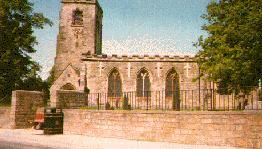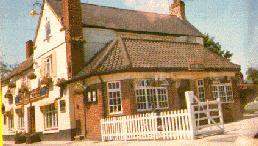

Calvertons most famous son is with out doubt William Lee, he invented the stocking machine in 1589 this invention changed Calverton and many other villages in the area as the stocking machines were installed in many of the cottages,the stocking machine even changed the buildings as the windows were designed to give maximum light on the machine.
AnotherCalvertonian was John Roe, he founded a religious sect in the late 18th century, it appears the method of choosing a partner was by casting lots,also he baptisms we held in a pool in his back garden (long dried up),he also gave us the Jonnie Roe plum, which is still grown locally.

Untilthe
1900 Century there were only 14 house's, farms and out building in
Calverton. There was no electricity, gas, piped water, or sewage works.
In1894
Sir Charles Seely supplied water taps at intervals along Main Street the
water was provide by a water pumping station in Hollinwood Lane.
During
the 1900's the Basford R.D.C., Coal Board, and Ciswo agreed to build
over 1000 new house's aimed at housing the miners which were mainly arriving
North East .
| Nameof public house | Locationpublic house | When first opened |
|
|
|
|
|
Scottish& Newcastle |
|
|
|
|
|
|
|
|
|
|
|
|
|
|
|



Places and buildings of interest locally...
Listed Grade II buildings..
Corner
cottage, The Avenue late 17th century brick
cottage
Weaver's
Cottage,
The
Avenue early 18th century brickwhite washed cottage
1-8
Windles Square,
Main
St . this when built in 1834 was a square of made up of
a
framework knitters cottages on three sides, unfortunately
now
only two side remained in an "L" shape .
Calverton
House,
Main
St, this former vicarage was built in the early 19th
century
built of rendered brick.
14and
16 Main Street, this was originally built
as an 18th
century
brick house but now however has been dived cottage
22
Main Street
this
is an early white washed brick house with a pentiled roof
Church
of St Winfrid
parts
of the church date back to the 11th century however
the
majority of the church is 17th century.
Mintas
Printing Works
Main
St, this is an early example of a 19th century brick factory.
150
Main Street,
this
three storey brick house built approximately 1775 has
adjoining
stable and cart shed.
Church
View,
49
Main Street, early 18th century white washed brick house
135
Main Street
white
washed brick house, this property has fixed on the wall
a
plaque which displays that this house was protected by the
private
fire fighting force in the village, any house not fitted
with
this plaque would not be helped in case of a fire..
Museum
Cottage,
Main
Street, this cottage built in 1780 is now the village museum.
This
museum displays a 200 year old handframe. The kitchen is set
out
as it would have been when the cottage was built, the bedroom
is
also laid out as an Edwardian style bedroom.
221
and 215 Main Street these were former framework
knitter
cottages
in the north gable still can been seen the brunt header
bricks
giving the date when they were built of MS 1857
Lodge
Farm House this early 18th century farm house
is a three
storey
building built in an "L" shape
Hollingwood
House, Hollingwood Lane this is a farm house
built in
the
early 1800.. There are many other places and building of
interest
these are just a few of the more notable.

Thereused to be a Lido (Out door swimming pool) this was fed by spring water,the temperature was to say the least a little on the cool side, as I can vouch for, the Lido has been there for many years, in fact I am told the way that you used to get there is by horse drawn coach. From a recent visit I have made to the Lido it appears to be in desperate need of repair, and unused .




Would
you like to visit and stay a while?

"Borrowside Farm"
Last
updated